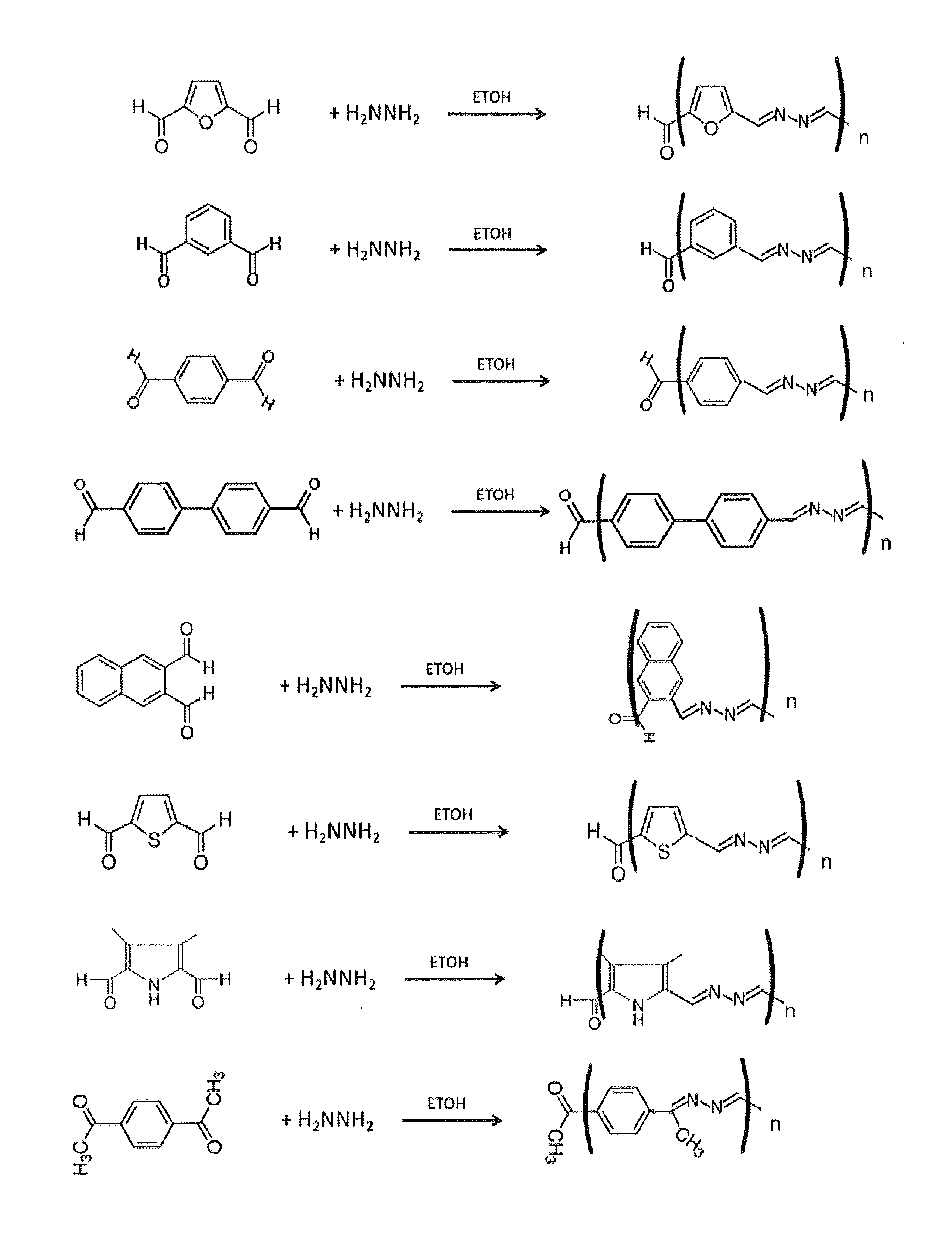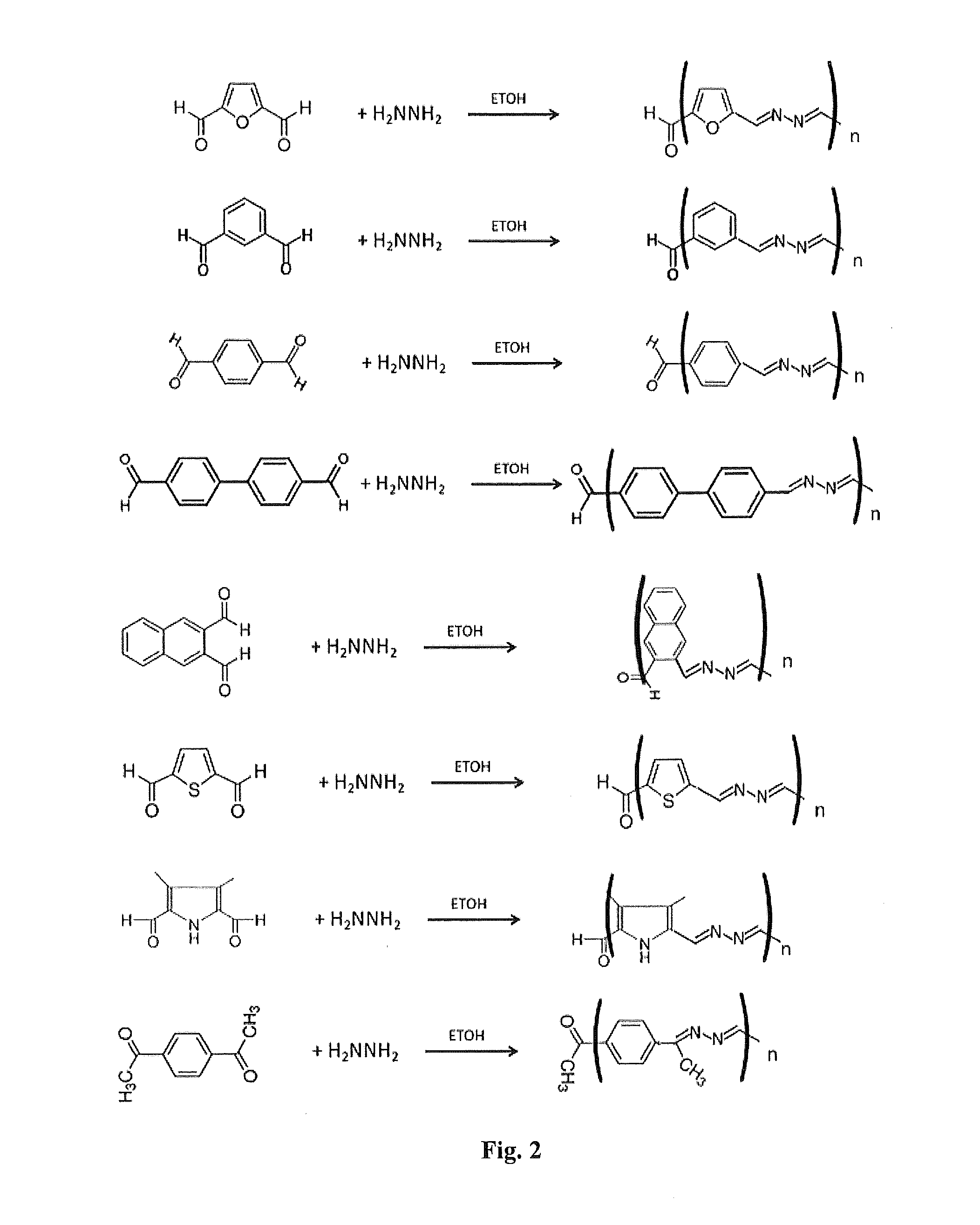Polymers, substrates, methods for making such, and devices comprising the same
- Summary
- Abstract
- Description
- Claims
- Application Information
AI Technical Summary
Benefits of technology
Problems solved by technology
Method used
Image
Examples
example 1
[0082]All reactions were carried out in approximately 50 mM potassium phosphate buffer, pH 6.5 with approximately 5 mM substrate and mushroom tyrosinase (polyphenol oxidase) Sigma T3824 in an amount of 100 to 10,000 units. Reaction volumes varied from 200 μl to 2 ml. In cases where substrates were not completely solubilized, then a saturated solution was used as the limit of solubility. In some cases, a solution of DMSO was used to increase solubility of the substrates. The enzyme was tested and shown to retain activity up to 50% DMSO. These cases are indicated in Table 1. The reactions were observed over a 24 hour period for the production of polymers, and the presence and color of polymer and solution was recorded.
[0083]The production of polymers in each reaction was visible as a precipitate in the well of a 96 well plate or in the reaction mixture on a glass slide.
TABLE 1Testing of polymer production in enzymatic tyrosinase (polyphenyl oxidase) reaction.ResultNotesSubstrate Teste...
example 2
Creation of Networked Polymer Sheets with Compound 2
[0084]In 50 μl of DMSO, 10 mg of compound 2 (Scheme 3) was dissolved and added to 10 mg of either indole, 5-hydroxyindole, 6-hydroxyindole, or serotonin that was dissolved in 50 μl DMSO.
[0085]The samples were polymerized by oxidation with 100 μl of 0.8 M ammonium persulfate in water in the case of indole and 5-hydroxyindole and 100 μl of 0.2 M ammonium persulfate in water in the case of 6-hydroxyindole and serotonin. These were compared to solutions of 50 μl 5-hydroxyindole, 6-hydroxyindole, and serotonin polymerized with equal volumes of the same concentrations of ammonium persufate without compound 2. Sheets of networked polymer were produced and examined microscopically at 200× and 400× magnification as shown in FIGS. 1A-D. 6-hydroxyindole did not network into a polymer sheet under these conditions. Controls of indole, 5-hydroxyindole and 6-hydroxyindole alone only formed amorphous dark particulate precipitates.
example 3
[0086]Polyazine polymers were synthesized as follows. 0.2 g of various dicarboxaldehydes were reacted with 0.03 g of hydrazine monohydrate (65%) or triaminobenzene in 15 ml of ethanol or acetonitrile to yield azadiene polymers (Table 2). In some cases, as with ketones, the PH was adjusted to about 5.0. In some cases these polymers were further modified (i.e., capped) by addition of indole or pyrrole moieties on the ends of the polymer chain by reacting the washed azadiene polymer with an 0.1 g of indole aldehydes or pyrrole aldehydes and 0.015 g of hydrazine monohydrate (15%) in 5 ml of ethanol or acetonitrile as described in Table 2. These resulted in capped polymers with the ends capped with one or more indole or pyrrole groups. Some of the capped polymers were subsequently crosslinked with an excess of 0.8 M ammonium persulfate.
[0087]FIG. 2 shows the synthesis of the azadiene polymers. FIG. 3 shows the synthesis of a networked benzene-1,3,5-azadiene polymer using 1,3,5 benzene tr...
PUM
| Property | Measurement | Unit |
|---|---|---|
| pH | aaaaa | aaaaa |
| volumes | aaaaa | aaaaa |
| structure | aaaaa | aaaaa |
Abstract
Description
Claims
Application Information
 Login to View More
Login to View More - R&D
- Intellectual Property
- Life Sciences
- Materials
- Tech Scout
- Unparalleled Data Quality
- Higher Quality Content
- 60% Fewer Hallucinations
Browse by: Latest US Patents, China's latest patents, Technical Efficacy Thesaurus, Application Domain, Technology Topic, Popular Technical Reports.
© 2025 PatSnap. All rights reserved.Legal|Privacy policy|Modern Slavery Act Transparency Statement|Sitemap|About US| Contact US: help@patsnap.com



